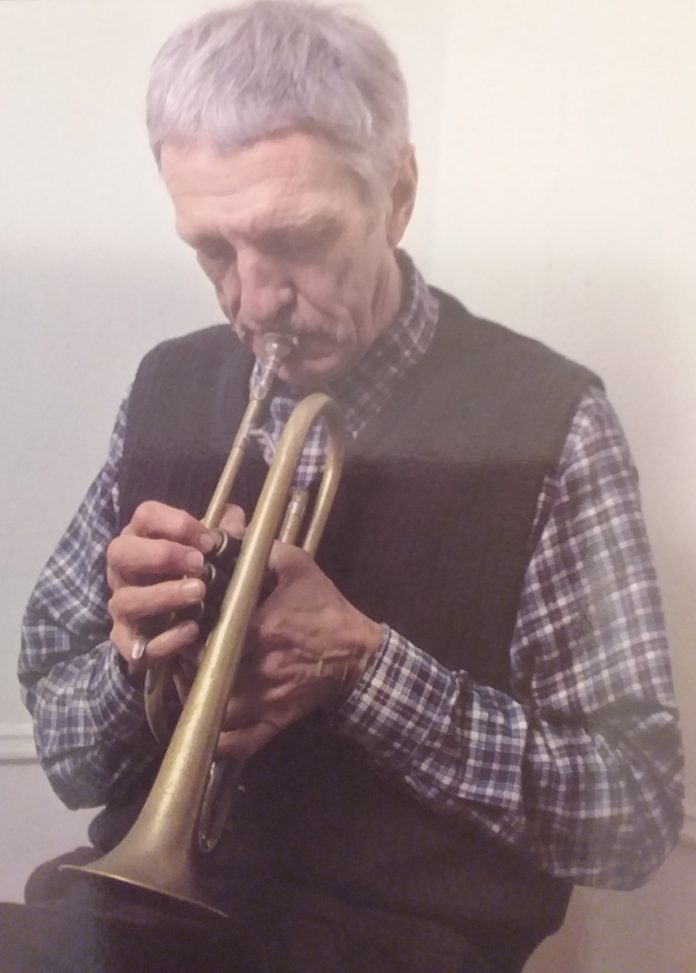The reputation of trumpeter Don Joseph (1923-1994) now depends on the slimmest of discographies. These performances reveal a technically fluent soloist with a disarmingly fragile lyrical quality reminiscent of earlier masters like Bix Beiderbecke and Bobby Hackett. But in his day Joseph’s fleeting appearances on the post-war jazz scene made a substantial impression on such contemporaries as Charlie Parker, Gerry Mulligan, Phil Woods, Bob Brookmeyer, Bill Crow and John Williams. The closest in style to Don Joseph at the time was probably Don Fagerquist on the West Coast.
On record there were three titles with Lucky Millinder’s orchestra in 1949 (one track has a trumpet solo but it is uncertain if it his), a 1952 live date with Dave Schildkraut, a 1954 session with Al Cohn, recordings in 1957 with Chuck Wayne and Gerry Mulligan, and a final date with Cohn again in 1984.
Don Joseph was born on Staten Island, 13 April 1923. He benefited from studying with the renowned trumpet teacher Haydn Sheppard, who was apparently the Carmine Caruso of his time. Michael Morreale, who knew him well, told me that Don would often have to demonstrate lip slurs together with exercises from the Arban trumpet method for the other students. A well-trained instrumentalist, he played Bach duets with colleagues throughout his career. (Michael is a very fine trumpeter himself as can be heard on YouTube where he and Don perform Embraceable You and Ash Wednesday Blues).
In 1940 Joseph had a quintet which for a while featured Manny Albam on alto. (Later Manny switched to the baritone with Georgie Auld, Charlie Barnet, Charlie Ventura and Herbie Fields before becoming one of the finest of the New York-based arrangers in the 50s.) During world war two Don played with most of the bands appearing at the Paramount Theatre in Times Square. Toward the end of the 40s he worked with Jerry Wald, Buddy Rich and Alvino Rey.
In 1950 Gene Roland selected him for the 25-piece band that rehearsed at Nola’s Studio with Charlie Parker. It became known as The Band That Never Was because it didn’t work, it just rehearsed. The ubiquitous Eddie Bert was there over four or five days of rehearsals taking photographs which can be found in Ken Vail’s excellent Bird’s Diary.
In 1951 Don was briefly with Buddy DeFranco’s big band and towards the end of 1951 Gerry Mulligan, encouraged by his girlfriend Gail Madden, started experimenting with a pianoless quartet with Don, Peter Ind and Al Levitt. The idea was to be fully realised with Chet Baker, Chico Hamilton and Bob Whitlock a few months later when Mulligan relocated to Los Angeles.
Joseph was recorded at the El Mambo club on Long Island in 1952 with Dave Schildkraut and Jackie Paris and both horns stretch out to good effect on Jackie’s Blues, Buzzy and Whooz Blues. Tom Lord claims the date to be 1961 but Fresh Sound on their Tribute To Don Joseph CD go with 1952 and my guess is that Fresh Sound boss Jordi Pujol is correct.
In 1953 Robert Reisner and Dave Lambert started featuring jazz at the Open Door in Greenwich Village and for a while it became a home-from-home for Don Joseph and his friends. Tony Fruscella, Brew Moore, Ronnie Singer and Freddie Gruber formed the resident band and sitting in was not only welcomed but encouraged. Occasionally some of the stars of the day were featured, including Charlie Parker, Thelonious Monk, Charles Mingus and Roy Haynes but not too often because remuneration was probably more generous elsewhere. There is a famous photo of them performing at the Open Door to be found in Ken Vail’s book. Bill Triglia, Phil Woods, Red Mitchell, Teddy Kotick, Nick Stabulas, Al Levitt and Art Mardigan were usually to be found there along with Don, who liked to perform Bach duets with Fruscella during the intervals.
A couple of young drummers were waiting their chance to sit in. When one of them took over and began pouring on the fire and brimstone, Don gave him a pained look and asked me ‘Whatever happened to that other drummer we had all nice and tired out?’
In Reisner’s book Bird – The Legend Of Charlie Parker bassist Ted Wald says “The summer of 1953 was wonderful. Those of us who lived in the Village got to play with Bird almost every day either at the Open Door or at Sheri Martinelli’s pad on 3rd Avenue and 4th Street. Don Joseph and Bird used to sound nutty together.” (Ms. Martinelli was a celebrated painter and a poet.) Just before he died, in March 1955, Parker visited Don in his room.
In his book Birdland To Broadway Bill Crow relates the following anecdote which sums up Don’s attitude to drummers. “Don Joseph and I were playing with Brew Moore at the Open Door. A couple of young drummers were waiting their chance to sit in. When one of them took over and began pouring on the fire and brimstone, Don gave him a pained look and asked me “Whatever happened to that other drummer we had all nice and tired out?”
Jack Kerouac and Alan Ginsberg were occasionally in attendance at the Open Door and Kerouac mentions Don and Tony Fruscella in his book Lonesome Traveler. This is what he says about Don: “Let’s go see if we can find Don Joseph… (he’s) a terrific cornet player who wanders around the Village with his little moustache and his arms hangin’ at the sides with the cornet which creaks when he plays softly, nay whispers, the greatest sweetest cornet since Bix and more. He stands at the jukebox in the bar and plays with the music for a beer. He looks like a handsome movie actor. He’s the great, super glamorous secret Bobby Hackett of the jazz world.”


